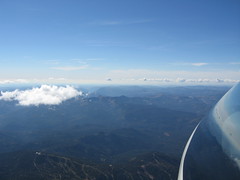Lance and I took up the DG-1000 on Saturday to see where we could go. After some struggling, we found that it was difficult to climb much above 12,800 feet. There were large areas of sink near Mount Rose and the good lift appeared to be only near the hot rocks and on the ridge leading to Verdi Peak.
About an hour or so into the flight another pilot called that he had contacted wave over the Truckee landfill at 12,500. We were just heading back from Verdi and went straight to the landfill. We contacted the weak wave and spent the next few hours exploring it.
The wave wasn't particularly strong or widespread, but we did our best. Eventually some of the nearby moisture came over and helped to form rotor clouds that would cycle every 10 minutes or so. That made it a bit easier to find the lift bands.
Our total flight time was just over four hours. I've posted the photos from the trip, including a few shots of the rotor clouds that appeared over Northstar.
The Summer soaring season is clearly winding down. The days are shorter, the thermals are shorter and weaker, and it gets downright cold at night in the mountains. About half the glider trailers have already left Truckee for the season. Pretty soon we'll have the brief Fall season, which can bring nice afternoons of local soaring near Hollister. Then it's time to gear up for the late Winter and early Spring pre-frontal wave and post-frontal thermal soaring.
Posted by jzawodn at September 18, 2005 09:26 PM | edit
Forgive my ignorance, but do glider passengers normally use oxygen or is gliding (and possibly ejecting with parachute) not considered strenuous enough for people who need oxygen?
Mike, it depends on the altitudes we're flying at. Above 10,000 feet, we generally use oxygen. In the mountains, it's common to get as high as 16,000 or 18,000 feet!
Ah.
BTW, are rotor clouds dangerous to gliders? I had never heard of them:
"Rotor clouds are of special concern to pilots as the descending air currents can trap a helicopteror airplane into a deadly fall - even at full power. Wintertime pilots are especially wary of rotors, and watch lenticulars very carefully as the same conditions can create the rotor clouds."
Extra oxygen isn't always necessary, but I've heard a Barf Bag is a good idea to bring on your first trip.
Hi Jeremy,
I have read your comments about rotor cloud. I will soon take part in wawe soaring in NZ and I have concerns about rotor clouds. Since I am not experienced I will take part at a course first. But in advance can you inform me about the manner of avoid rotor clouds, or rotor events ?
Does rotor event means a cloud as well? Height of rotor cloud compared to the peak of the mountain ? Do aou have any desription about rotor clouds? Any useful advise on rotor event ? Thank you in advance..
Best regards, Zsolt, Hungary
please use my email address

